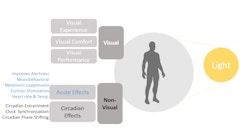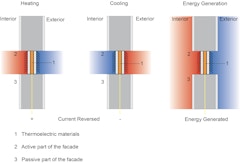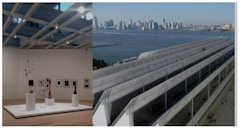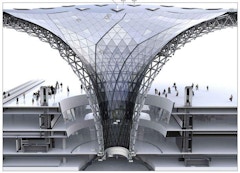
213 results
-
 A proposed design for a compact, closed cavity, double-skin curtain wall system in the Marine climate of the West Coast raises questions of potential…
A proposed design for a compact, closed cavity, double-skin curtain wall system in the Marine climate of the West Coast raises questions of potential… -

Performance-based Facade Framework
- Paper by Mahsa Minaei · Ajla Aksamija
Buildings have a considerable impact on the environment, and it is crucial to consider environmental and energy performance in building design.
-
Performance Criteria for Museum Enclosure Design
- Paper by Karen Brandt
This paper develops a framework of considerations for the development of project specific performance criteria for the design of art museums and
-

Performance Based Generative Facade Workflow for Large Scale Projects
- Paper by Paul Ferrer · Mili Kyropoulou · Tim Logan · Heath May · James Warton
Over the last two decades, in what has been coined “The Digital Turn”, the introduction of parametric design software has afforded increased
-

Blast Performance of TSSA
- Paper by Jon H. Kimberlain, Lawrence D. Carbary,
Architectural preferences for commercial building continue towards increased transparency resulting in large lites of glass with minimal visual… -
Blast Performance
- Paper by Jon Kimberlain, Principal TS&D Scientist Jie Feng, Research Scientist Will Wholey, Associate Dan Aggromito, Senior Consultant Valérie Hayez, Principal Scientist
Designing for blast performance for glazing units can be very complex. The test methods for evaluating performance include subjecting units to actual… -

Thermal Performance of Closed Cavity Facades
- Paper by Andrea Zani, Project Engineer Carmelo Guido Galante, Senior Project Engineer Lisa Rammig, Senior Associate
Closed cavity facades (CCF), a configuration of Double Skin Facade (DSF), consists of a double-glazed unit on the inner layer and single glazing on… -
Influence of Performance and Design of Structural Silicone Joints on the Resilience of Curtain Wall Units Exposed to Seismic Impacts
- Paper by Viviana Nardini, Market Field Engineer Facade / Insulating Glass Florian Doebbel, Business Development Manager, Facades
Facade failure due to seismic event represents a potential hazard to people and can cause serious damages to buildings with consequent high-cost… -

Circadian Daylight Performance of the Electrochromic Glazing
- Paper by Ahoo Malekafzali. PhD.
Electrochromic windows introduced to building market as a smart glare control solution to provide visual comfort for building occupant. EC glazing
-

Verifying Thermal Performance
- Paper by Matthew Herman, Mark Walsh,
Architects specify curtain wall thermal performance criteria and usually identify simple modeling software, like THERM, to perform thermal analysis… -
Facades for High-Performance Workplaces
- Paper by Christopher Payne, AIA, LEED AP, Assoc. DBIA
How has the role of the façade evolved in light of the COVID-19 pandemic and ongoing fight to combat the climate change crisis? As companies grapple
-
Evaluating The Environmental Performance Of Stick Curtain Wall Systems
- Paper by Dima Othman · Daniel Arztmann
The construction industry is one of the greatest sources of pollution, where 39% of global energy-related carbon emissions are attributed to
-

Two Sides to Sustainability & High-performance
- Paper by Brian Fraumeni, Associate, Project Designer Julia Ragragio Ruiz, LEED AP BD+C, Sustainability Strategist Adam Moqrane, Intern
High performance can be defined as “a building that integrates and optimizes all major high-performance building attributes, including energy… -

Effect of Thermal Bridging on Buildings' Energy Performance
- Paper by Mahsa Farid Mohajer · Ajla Aksamija
Heat transfer through building facades can occur by any combinations of conduction, convection, and/or radiation. Conductive heat transfer depends on
-

Novel Active Facade Systems and Their Energy Performance in Commercial Buildings
- Paper by Ajla Aksamija · Mahsa Farid Mohajer · Zlatan Aksamija
This article presents results of a research study that focuses on understanding energy performance of novel facade systems that integrate
-

Data-Driven Shading Systems
- Paper by Simon Schleicher, Luis Santos, Luisa Caldas,
Analyzing the energy performance of complex building envelopes, determining the need for sun protection, and assessing the effectiveness of shading… -

The Facade and Energy Codes
- Paper by Elliot Glassman
Ever-increasing performance requirements in the latest version of the energy codes are compelling project teams to consider the thermal performance
-

Multi Layer Facades
- Paper by Robert Moisy,
The history of high performance facades and glazing has been a tale of attempting to manage the conflicting requirements of, on one hand inviting… -
Form as Energy
- Paper by Matthew Fineout
All too often, high-performance building envelopes are considered in terms of new materials and technologies that push specific systems to improve
-

Facade Expansion Joint Systems
- Paper by Kevin W. Smith, PE, CWI
As awareness around the seismic performance of buildings grows, it is becoming increasingly necessary to integrate seismic expansion joint cover

